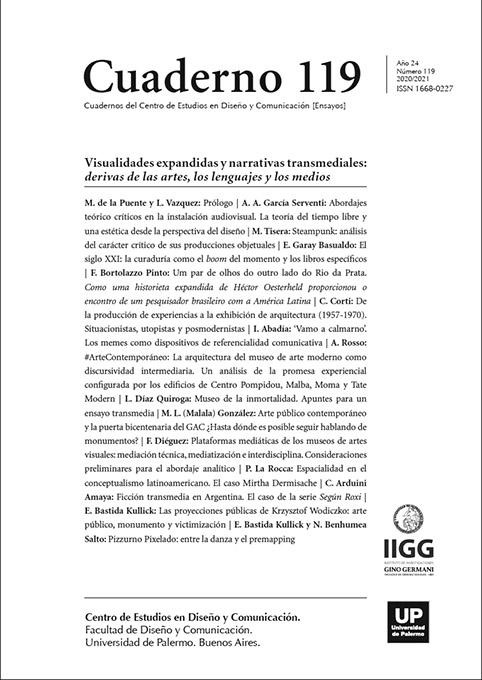Steampunk: análisis del carácter crítico de sus producciones objetuales
Abstract
In this paper we address the genealogy of this concept that seeks to contextualize the works that take place in the future imagined by the science fiction writers Jules Verne and H. G. Wells, in the late nineteenth century. Turned into a subculture in the 1990s, Steampunk recovers for its aesthetics elements of the Victorian machine. This procedure can be observed today, and increasingly so, in the different fields of visual production. The analysis aims to analyse the ways in which some of the objects produced by this subculture acquire a critical dimension.
References
Bookchin, M. (1999). La Ecología de la Libertad. La Emergencia y la Disolución de las Jerarquías. Madrid: Nossa y Jara Editores.
Calamity, P. (2007). Entrevista por Marian Kuemmerlein, “Calamity and Catastrophe. Steampunks and the War Against Electricity”, The L Magazine. Vol. 5, No. 14. [Texto online consultado en julio de 2012.] http://www.thelmagazine.com/newyork/calamity-andcatastrophe/Content?oid=1138458.
Catastrophone Orchestra and Arts Collective (2006). “What then is Stampunk?” The SteamPunk Magazine, Nº 1.
Clute, J. y Grant, J. (1999). “Steampunk”, The Encyclopedia of Fantasy, Contributing editors: Mike Ashley, Roz Kaveney, David Langford, Ron Tiner (Rev. edición), New York: St. Martin’s Griffin.
Gross, C. (2006). “Varieties of Steampunk Experience”, SteamPunk Magazine, Nº 1.
Han, B-C. (2005). La Salvación de lo Bello. Buenos Aires: Herder.
Kuemmerlein, M. (2007). “Calamity and Catastrophe. Steampunks and the War Against Electricity”, The L Magazine. Vol. 5, No. 14. [Texto online consultado en julio de 2012]. http://www.thelmagazine.com/newyork/calamity-and-catastrophe/Content?oid=1138458.
Manzini, E. (1996). Artefactos. Hacia una nueva ecología del ambiente artificial. Madrid: Celeste Ediciones.
Millás, J. J. (1982). Prólogo a la obra de Wells H. G., La máquina del tiempo. Madrid: Hyspamerica / Ediciones Generales Anaya.
Mumford, L. (2006). Técnica y Civilización. Madrid: Alianza. Título original: Technics and Civilization, 1934.
Mumford, L. (2010). El Mito de la Máquina. Técnica y Evolución Humana, Logroño: Editorial Pepitas de Calabaza. Título original: The Myth of the Machine. Technics and Human Development, 1967.
Nagy, R. (2011). “Sweat, Steam, and Mods: Steampunk Makers”, The Steampunk Bible. An illustrated guide to the world of imaginary airships, corsets and goggles, mad scientists, and strange literature. New York: Abrams Image.
Nagy, R. Datamancer. Modern Heirlooms with Classic Style. [Texto online consultado en julio de 2012] http://www.datamancer.net.
Norman, D. (2005). El diseño emocional. Barcelona: Paidós.
Onion, R. (1998). “Reclaiming the Machine: An Introductory Look at Steampunk in Everyday Practice”. Revista digital Neo-Victorian Studies Nº 1.
Pauwels, L. y Bergier, J. (1975). El retorno de los brujos. Barcelona: Plaza & Janés. Título original: Le Matin des Magiciens, 1960.
Pevsner, N. (2000). Pioneros del Diseño Moderno. Buenos Aires, Ediciones Infinito.
Slatt, J. V. (2009). Entrevista por Inés Muñoz Martínez-Mora, “Punk del siglo XIX”, El País.com. [Texto online consultado en julio de 2012].
Slatt, J. V. (2011). “A Steampunk Manifesto”, The Steampunk Bible. An illustrated guide to the world of imaginary airships, corsets and goggles, mad scientists, and strange literature. New York: Abrams Image.
Los autores/as que publiquen en esta revista ceden los derechos de autor y de publicación a "Cuadernos del Centro de Estudios de Diseño y Comunicación", Aceptando el registro de su trabajo bajo una licencia de atribución de Creative Commons, que permite a terceros utilizar lo publicado siempre que de el crédito pertinente a los autores y a esta revista.


